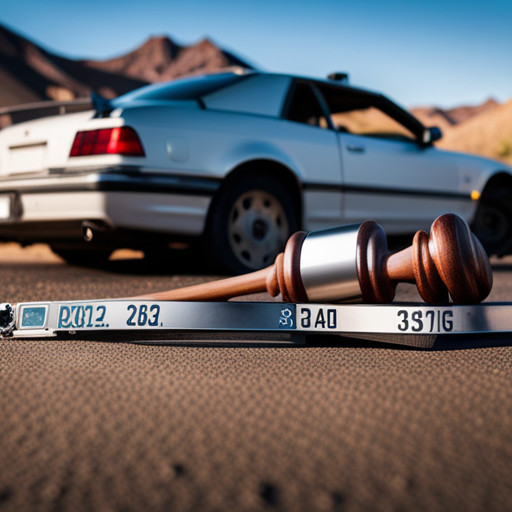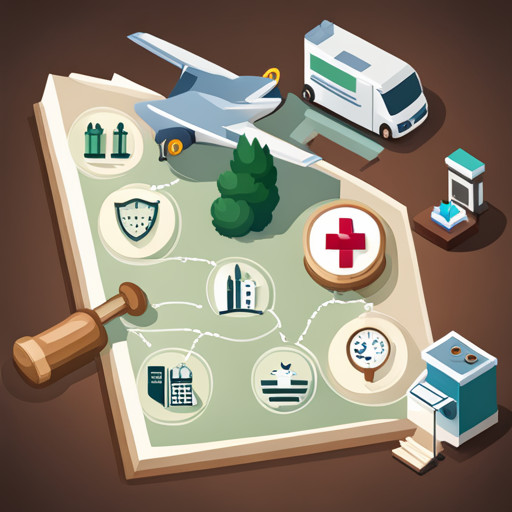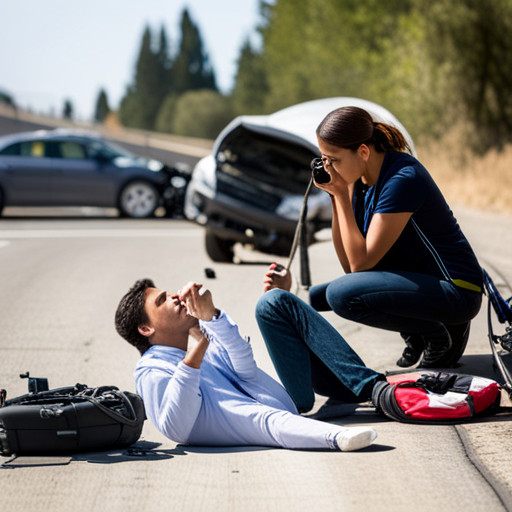California Car Accident Guide Get Fair Compensation for Injuries
Undeniably, navigating post-accident procedures in California can be complex due to its adherence to the pure comparative fault rule.

This article provides a comprehensive guide on understanding immediate post-accident steps, California's liability rules, the process of securing just compensation, and the importance of evidence gathering.
It also explores the intricacies of dealing with uninsured motorists, the impact of pre-existing conditions on claims, and the crucial role legal representation plays in car accident claims.
Key Takeaways
- Stay at the scene of the accident and exchange information according to California car accident law.
- Seek prompt medical treatment, even for seemingly minor injuries, and gather copies of medical bills and records.
- California follows a pure comparative fault rule, allowing you to seek compensation as long as you aren't solely at fault.
- Gathering evidence from the scene, such as the police accident report, photographs, video, and independent witness statements, is crucial for proving the other driver caused the crash.
Understanding the Immediate Steps Post-Accident

Upon the unfortunate occurrence of a car accident in California, it is crucial to adhere to immediate steps such as remaining at the scene, exchanging relevant information, and seeking prompt medical attention, all in accordance with state law.
Navigating insurance claims post-accident is a pivotal process. This involves immediate notification of the incident to the respective insurance company, and initiating the claims process.
Crucially, regardless of perceived injury severity, individuals should promptly seek medical treatment. This not only ensures health safety but also establishes a vital link between the accident and any ensuing injuries, thereby strengthening the insurance claim.
Thus, understanding and executing these immediate steps post-accident serve to protect individuals' rights and facilitate the claims process.
Navigating California Fault and Liability Rules

Understanding the fault and liability rules is paramount when seeking redress after a motor vehicle mishap in the Golden State.
California operates under the pure comparative negligence system, which allows for compensation even if the claimant is partially at fault, though the amount of damages is reduced by the percentage of fault. This understanding of comparative negligence laws is crucial when dealing with insurance adjusters, who are often seeking to minimize payout amounts.
It is also vital to note that California is not a no-fault state; thus, one can seek compensatory damages from the at-fault party.
Consequently, knowledge of fault and liability rules is a critical arsenal in the pursuit of fair compensation following a vehicular accident in California.
The Process of Accident Compensation in California

Navigating the process of accident compensation requires a keen understanding of the specific procedures and legal requirements in place.
The compensation process overview begins with an injury resulting from a negligent driver, triggering an entitlement to compensation. The usual course involves filing a claim with the at-fault driver's insurance company.
If negotiations are unsuccessful, the legal requirements for compensation permit a lawsuit against the at-fault driver. Crucial to this process are medical records explicitly linking injuries to the accident.
It is noteworthy that California upholds a pure comparative fault rule, reducing compensation in proportion to the claimant's percentage of fault.
In essence, the legal requirements for compensation in California are complex, necessitating thorough knowledge and careful navigation.
Importance of Gathering Evidence From the Scene

Acquiring adequate and convincing evidence from the scene of the incident is an integral component in establishing fault and seeking compensation in motor vehicle incidents. This process carries significant weight in the legal realm, particularly in cases where fault is disputed.
The importance of eyewitness testimony cannot be overstated. These accounts provide a firsthand perspective of the incident, potentially corroborating or refuting claims made by involved parties.
The role of video surveillance has grown exponentially. It offers an unbiased, accurate representation of events, often proving indispensable in fault determination.
Physical evidence, such as skid marks, vehicle damage, and debris can also aid in reconstructing the accident.
Official reports by law enforcement and medical personnel provide a professional, objective overview of the accident and resulting injuries.
Necessity of Notifying Both Insurance Companies

Prompt notification of both insurance companies following a motor vehicle incident is a crucial step in the claims process. In dealing with insurance companies, a claimant's ability to negotiate a fair settlement is often contingent on the timeliness and completeness of the claim notification.
The table below outlines key steps in this process:
| Steps | Importance | Impact |
|---|---|---|
| Notify Own Insurance | Obligatory under most auto policies | Facilitates cooperation in investigations |
| Notify At-Fault Party's Insurance | Enables claim initiation | Enhances possibility of fair settlement |
| Provide Complete Information | Ensures accurate claim assessment | Increases chance of success in claim |
Negotiating a fair settlement requires diligence, patience, and a thorough understanding of the legal landscape surrounding motor vehicle incidents.
The Role of Medical Documentation in Claims

Thorough medical documentation serves as unequivocal evidence in substantiating claims for damages incurred due to motor vehicle incidents. The role of medical records is paramount in the litigation and compensation process.
- Medical records provide verifiable proof of injuries, their extent and the need for treatments.
- These records provide a timeline that correlates the accident with the injuries sustained.
- Documented medical history can discount pre-existing conditions being mistaken for accident-induced injuries.
- Accurate documentation aids in the calculation of just compensation, including medical expenses, loss of earnings, and pain and suffering.
Undeniably, the importance of documentation cannot be overstated in this context. It underpins the claimant's case, providing the necessary legal basis for arguing and determining fair compensation.
Dealing With Uninsured or Underinsured Motorists

Following the analysis of medical documentation's impact on claims, attention should now pivot to the challenges encountered when dealing with uninsured or underinsured motorists. In such scenarios, the availability of uninsured motorist coverage becomes vitally important.
This special type of insurance protects individuals who might otherwise be left without financial recourse following a collision with a driver lacking sufficient insurance. It also covers hit-and-run incidents. Additionally, it often provides for medical treatment options, thereby ensuring injured parties retain access to necessary healthcare.
It is a prudent choice for drivers to consider, given the rising number of uninsured or underinsured motorists on the road. In essence, it offers a safety net, safeguarding the insured from potential financial devastation following a motor vehicle accident.
The Impact of Pre-existing Conditions on Claims

Navigating the intricacies of insurance claims becomes further complicated when pre-existing conditions are introduced into the equation. These conditions can significantly impact the claim process, especially in California, where the compensation might be reduced based on the comparative fault rule.
- Pre-existing conditions may diminish the overall compensation due to the difficulty of distinguishing new injuries from prior health issues.
- Insurance companies might deny claims, arguing the accident did not cause the injury but merely exacerbated a pre-existing condition.
- Legal guidance is often necessary to argue for the rightful claim in such complex situations.
- Uninsured motorists add another layer of complexity, as dealing with them often involves complex legal procedures and negotiations.
Understanding these aspects is crucial for securing fair compensation in the aftermath of an accident.
The Role of Legal Representation in Car Accident Claims

After extensive exploration of the influence of pre-existing conditions on accident claims, attention now turns to the critical issue of legal representation in car accident claims.
The role of attorneys in such claims cannot be underestimated. Legal representation offers significant benefits, providing a bridge between complex legal jargon and the layperson's understanding. Attorneys play an integral role in negotiating with insurance companies, preparing and filing necessary legal documents, and advocating for the claimant's rights and interests in court if necessary.
They bring in-depth knowledge of the law, strategic negotiation skills, and a commitment to securing fair compensation. Overall, the value of legal representation in ensuring a successful and fair car accident claim in California is considerable and indeed indispensable.
Understanding the Long-term Effects of Car Accidents

Understanding the long-term effects of vehicular collisions necessitates a thorough examination of both physical and psychological outcomes. This includes chronic health issues that may arise from severe injuries sustained, requiring extended medical treatment and potentially leading to permanent disability. Additionally, decreased quality of life often results from the inability to perform daily tasks or enjoy previous hobbies due to physical limitations or psychological trauma. Understanding psychological trauma is crucial as accidents can lead to conditions like Post-Traumatic Stress Disorder (PTSD), affecting victims' mental health. Seeking compensation for property damage is also integral to the recovery process, providing financial relief from the burden of unexpected expenses.
The long-term impact of vehicular collisions extends beyond immediate physical injuries, underscoring the importance of comprehensive medical and psychological treatment, as well as appropriate legal action.
Frequently Asked Questions
What Are the Qualifications I Should Look for in a Car Accident Attorney in California?
When seeking a car accident attorney in California, focus on their experience in handling similar cases, their success rate, and their understanding of California's specific laws and regulations.
Furthermore, evaluate the structure of their legal fees - whether they operate on a contingency fee basis, where payment is only required if compensation is successfully obtained.
It's also crucial to assess their communication skills, reputation, and their willingness to go to trial if needed.
How Can I Protect My Rights if the At-Fault Driver’s Insurance Company Contacts Me?
In the event of contact from the at-fault driver's insurance company, it is imperative to exercise caution. Recorded statements should not be given without legal counsel, as they can be used against the claimant in insurance negotiations.
Legal representation is recommended for navigating these discussions, protecting the claimant's rights, and ensuring a fair outcome. It is advisable to consult with a legal professional before engaging in any communication with the opposing insurance company.
What Happens if I Am a Pedestrian or a Cyclist Involved in a Car Accident?
In incidents involving motor vehicles and pedestrians or cyclists, the rights of the latter must be considered. California law stipulates that pedestrians and cyclists have the same rights and responsibilities as motorists. This includes the entitlement to seek compensation for damages or injuries suffered in an accident.
The protection of cyclists and pedestrians is integral to fair and equitable traffic laws, and understanding these rights can aid in navigating post-accident procedures.
How Does the Process of Filing a Claim Differ if the Car Accident Happened in a Private Property, Like a Parking Lot?
In the event of a vehicular accident on private property, such as a parking lot, the claim filing process may differ due to Private Property Regulations. Parking Lot Liabilities can complicate matters, necessitating a thorough investigation of the accident's circumstances.
It is critical to gather evidence, notify all involved insurance companies, and consult with a legal expert to navigate the complexities of liability and compensation claims in these unique situations.
Are There Any Specific Laws in California for Car Accidents Involving Out-Of-State Drivers?
In California, car accidents involving out-of-state drivers are subject to the same liability rules as those involving resident drivers. The state's jurisdiction applies, meaning California's pure comparative fault rule is in effect.
Regardless of the driver's state of residence, if they are at fault, they bear responsibility. Out-of-state drivers are also obliged to comply with the California insurance requirements and are equally liable for compensatory damages in case of negligence.

This post has been generated by AI and was not reviewed by editors. This is Not legal advice. Please consult with an attorney.




